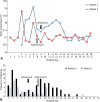Abstract
Shigella is a common cause of bacterial enteritis worldwide. Shigella sonnei accounts for 90% of Shigella infections and Shigella flexneri is rarely reported in Korea. Although the incidence of Shigella infection has decreased, the incidence of organisms with antibiotic resistance has gradually increased in Korea. An outbreak of extended-spectrum β-lactamase (ESBL)-producing S. sonnei in children was reported in Korea; however, ESBL-producing S. flexneri has not yet been reported. We report the first two cases of multidrug-resistant CTX-M-14-producing S. flexneri infections in Korean children.
Figures and Tables
Fig. 1
The pulsed filed gel electrophoresis (PFGE)-NotI patterns from outbreak strains of Shigella flexneri 2a. AMP, ampicillin; SAM, amoxicillin/clavulanic acid; CEP, cephalothin; CTX, cefotaxime; NAL, nalidixic acid; CHL, chloramphenicol; TET, tetracycline; SXT, trimethoprim-sulfamethoxazole.

References
1. Chun JH, Kim SH, Jeon HG, Kim JY, Kang YH, Shin KH, et al. Epidemiological characterization of Shigella flexneri isolates in Korea and the analysis of pulsed-field gel electrophoresis patterns. J Bacteriol Virol. 2002; 32:11–22.
2. Ki HK, Kim SH, Kee HY, Seo JJ, Kim ES, Ha DR, et al. Investigation of outbreak caused by Shigella flexneri. Infect Chemother. 2004; 36:155–163.
3. Lee JC, Jeong YS, Oh JY, Kang HY, Kim KH, Kim J, et al. Epidemiology of shigellosis in Korea. J Bacteriol Virol. 2006; 36:41–49.

4. Arvelo W, Hinkle CJ, Nguyen TA, Weiser T, Steinmuller N, Khan F, et al. Transmission risk factors and treatment of pediatric shigellosis during a large daycare center-associated outbreak of multidrug resistant Shigella sonnei: implications for the management of shigellosis outbreaks among children. Pediatr Infect Dis J. 2009; 28:976–980.

5. Cho IJ, Yim J, Lee Y, Kim MS, Seo Y, Chung HS, et al. Trends in isolation and antimicrobial susceptibility of enteropathogenic bacteria in 2001–2010 at a Korean tertiary care hospital. Ann Clin Microbiol. 2013; 16:45–51.

6. Korea Centers for Disease Control and Prevention. Infectious diseases surveillance yearbook. Cheongju: Korea Centers for Disease Control and Prevention;2014. p. 499.
7. Min YS, Lim HS, Lee K, Lim SH, Lee BS. Epidemiologic investigation on an outbreak of shigellosis in Seongju-gun, Korea, 2003. J Prev Med Public Health. 2005; 38:189–196.
8. Kim J, Kim S, Jeon S, Kang Y, Jeon D, Kim J, et al. The first outbreak of shigellosis caused by Shigella dysenteriae type 8 in Korea. Korean J Clin Microbiol. 2005; 8:153–159.
9. Lim HT, Lee SH, Lee JH, Kim JE, Kim KS, Jeong EJ, et al. A domestic outbreak of bacterial dysentery caused by extended-spectrum beta-lactamase (ESBL)-producing Shigella sonnei. Korean J Pediatr. 2005; 48:1107–1115.
10. Lim HS, Lee HS. An epidemiological investigation on an outbreak of shigellosis during travelling Cambodia and Vietnam among Korean rural people, 2005. J Agric Med Community Health. 2009; 34:368–374.

11. Wong MR, Reddy V, Hanson H, Johnson KM, Tsoi B, Cokes C, et al. Antimicrobial resistance trends of Shigella serotypes in New York City, 2006–2009. Microb Drug Resist. 2010; 16:155–161.

12. Lee W, Chung HS, Lee H, Yum JH, Yong D, Jeong SH, et al. CTX-M-55-type extended-spectrum beta-lactamase-producing Shigella sonnei isolated from a Korean patient who had travelled to China. Ann Lab Med. 2013; 33:141–144.

13. Ko CF, Lin NT, Chiou CS, Wang LY, Liu MC, Yang CY, et al. Infrequent cross-transmission of Shigella flexneri 2a strains among villages of a mountainous township in Taiwan with endemic shigellosis. BMC Infect Dis. 2013; 13:354.

14. Yang H, Chen G, Zhu Y, Liu Y, Cheng J, Hu L, et al. Surveillance of antimicrobial susceptibility patterns among Shigella species isolated in China during the 7-year period of 2005–2011. Ann Lab Med. 2013; 33:111–115.

15. Yang H, Sun W, Duan G, Zhu J, Zhang W, Xi Y, et al. Serotype distribution and characteristics of antimicrobial resistance in Shigella isolated from Henan province, China, 2001–2008. Epidemiol Infect. 2013; 141:1946–1952.

16. Ochoa TJ, Kosek M. Shigella. In : Feigin RD, Cherry JD, editors. Textbook of pediatric infectious diseases. 7th ed. Philadelphia: WB Saunders Co;2014. p. 1476–1486.
17. Korea Centers for Disease Control and Prevention. Infectious disease surveillance [Internet]. Cheongju: Korea Centers for Disease Control and Prevention;c2012. cited 2016 Oct 18. http://www.cdc.go.kr/CDC/info/CdcKrInfo0210.jsp?menuIds=HOME001-MNU1154-MNU0725-MNU1375-MNU0566&cid=3099.
18. Hong SJ, Lee CH, Wang JH, Song W, Jung SH. Clinical characteristics of extended-spectrum beta-lactamase producing Shigella sonnei infection outbreaked in Chungju Area. Korean J Lab Med. 2006; 26:168–173.

19. Sangeetha AV, Parija SC, Mandal I, Krishnamurthy S. Clinical and microbiological profiles of shigellosis in children. J Health Popul Nutr. 2014; 32:580–586.




 PDF
PDF ePub
ePub Citation
Citation Print
Print





 XML Download
XML Download